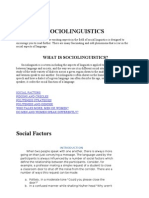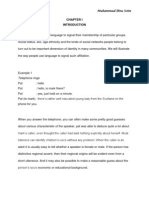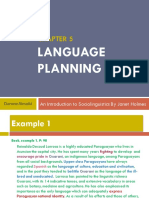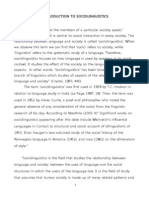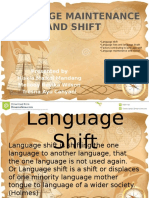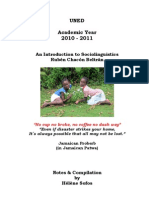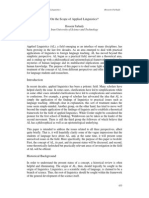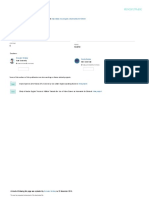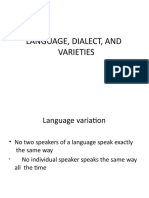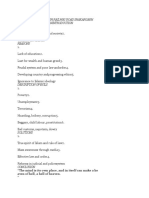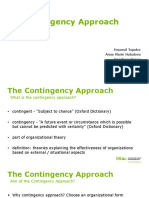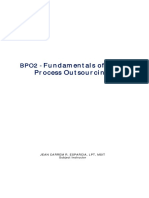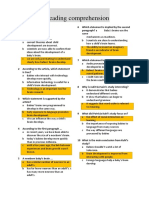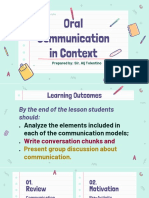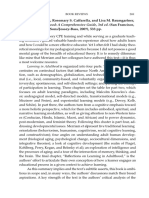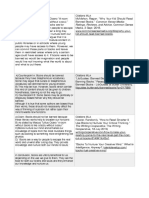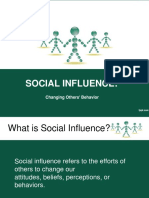Language, Dialect, Varieties
Hareem
Afsha
Hassan
Bilal
Sociolinguistics
Sociolinguistics, the study of the sociological aspects of language. The discipline concerns itself with the
part language plays in maintaining the social roles in a community. Sociolinguists attempt to isolate
those linguistic features that are used in particular situations and that mark the various social
relationships among the participants and the significant elements of the situation
VARIATIES...
Hudson (1980: 24)
A set of linguistic items with similar distribution
Ferguson (1971: 30)
Any body of human speech patterns which sufficiently homogeneous to be analyzed by available
techniques of synchronic description and which has a sufficiently large repertory of elements and their
arrangements or process with broad enough semantic scope to function in all normal context of
communication.
VARIATIES
Wardaugh (1988: 20) a specific set of linguistic items or human speech patterns (presumably, sounds,
words, grammatical features) which we can uniquely associate with some external factors (presumably,
a geographical area and a social group)
VARIETY IN LANGUAGE
Variety in language refers to various forms of languge triggered by some social factors such as
social situation, occupation, age, gender, education, geography, social status, and ethinicty.
A language may change from region to region, one social class to another, individual to
individual, and situation to situation. This actual change results in the varities of language.
LANGUAGE VARIATION
Language variations mean regional, social, or contextual differences in the way a particular
language is used. Language varies in many dimensions.
�1. Geographical 2. Social
3. Style 4. Function
Language is subject to variation and it varies with distance. It is said that language changes it’s
forms every ten miles away.
language changes at three levels which are:
1. Level of vocablury
2. Grammatical level
3. Level of pronunciation
Conti...
Variation on the level of vocabulary:
Holiday/ vacation, cookie/ biscuit, movie/ cinema
Variation on the level of pronunciation:
Variation on the level of grammar:
British English American English
1. i´ve lost my key. I lost my key.
2. Do you live in this street? Do you live on this street?
3. Have a shower. Take a shower.
4. Have you got a problem? Do you have any problem?
LANGUAGE & IT’S LEVELS
The method of communication, either written or spoken, consisting of the use of words in a
structural and conventional way.
Language is distributed into two levels.
1. Standard language
2. Non-standard language
STANDARD LANGUAGE
� A standard language is ”a variety that in different ways, is recognized as more correct and
acceptable than other varieties. In many ways, standard variety is an equally appropriate
designation”.
For instance, standard English is the variety which forms the basis of printed English in
newspapers and books or which is taught in schools.
Standard English is usually taught to those who learn English as a Second language.
NON-STANDARD LANGUAGE
The term non-standard was originally used by linguists to reffer to language varieties that had
previously been labeled with terms such as vuglar.
Non-standard English differs from Standard English at the level of Grammer. It does not follow
the grammatical structure of Standard language.
DIALECT
A particular form of language which is peculiar to a specific region or social group.
A variety of language that signals where a person comes from. The notion is usually interpreted
geographically, but it also has some application in relation to a person´s social background.
For instance, Hey!, Howdy!, Yo!, Hi!, are some forms of Hello which are used in different groups
and regions.
KINDS OF DIALECTS
Dialects are divided into two types on the basis of their use in different classes and placess.
There are two types of dialects.
1. Social dialect
2. Regional dialect
SOCIAL DIALECT
A variety of speech associated with a particular social class or occupational group within a
society.
Social dialect is also called sociolect.
Social dialect is not spoken by all members of a particular group.
In social dialect, distance is not an important factor. It can easily be influenced by social barriers.
REGIONAL DIALECT
� Regional dialect is a distinct form of a language spoken or used in a particular geographical area.
It is also known as Regiolect or Topolect.
It is spoken in one particular area of a country.
It is affected by geographical factors. Dintance is the main and important factor.
IDIOLECT
A variety of a language unique to an individual. Every individual has an idiolect.
The grouping of words and phrases is unique rather than an individual using specific words that
nobody else uses.
Idiolects change through contact with other idiolects and change throuhout their lifetime as well
as from generation to generation
DIALECT
PRESTIGE & STIGMA
A prestige variety is a dialect associated with mainstream social prestige-for example, a dialect
that sounds ”educated” or ” sophisticated”.
A stigmatized variety is a dialect associated with negative features, from a mainstream social
perspective: e.g. ”uneducated” ”lower class”.
DIALECT CONTACT
Contact between linguistic varieties which results from communication between speakers of
different but mutualy intelligible dialects, often involving accomodation.
Such communication is of course very common indeed, but, from the point of view of
sociolinguistics, such contacts are partiularly interesting where they occur on large scale, such as
at dialect boundaries (isogloss) or as result of urbanization or colonization. In these cases,
phenomena such as dialect mixture.
DIALECT MIXTURE
A consequence of large scale, long term dialect contact in which face-to-face interaction
between speakers of different dialects, stemming from developments such as emigration or
urbanisation, leads to accomodation between these speakers and thus the mixing of different
dialect form.
The end result of the mixture may umtimately be the formation of a new dialect, such as
Austrailian English, with speakers selecting a combination of forms from different dialects which
are present in the mixture for retention, and discarding others. The new dialect will typically
have the linguistic characteristics of a koine.
�WHY DO SOME DIALECTS HAVE MORE PRESTIGE THAN OTHERS?
Some dialects have more prestige
1. Historical factors
2. Other factors
Such dialect is called standard or consensus dialects.
This designation:
1. Externally imposed
2. The prestige of a dialect shifts as the power relationship
3. The prestige of the speakers shift
WHAT IS ACCENT ?
In linguistics, an accent is a manner of pronunciation peculiar to a particular individual, location,
or nation. An accent may identify the locality in which its speakers reside (a geographical or
regional accent), the socio-economic status of its speakers, their ethnicity, their caste or social
class, their first language (when the language in which the accent is heard is not their native
language), and so on.
DIALECT/ ACCENT
Dialect must be not confused with accents.
Everybody speaks a dialect with an accent. These concepts may be close but they are not the same
Dialect
Refers to broader set of linguistic differences.
A variety refers to Grammatical and phonological features.
Accent
Refers to the differences in pronunciation.
A variety refers to the phonological and phonetic features.
REGISTERS
Variation in speech style based on familiarity.
Halliday, the father of registers, defines it as:
”the relationship between language (and other semiotic forms) and the features of the context”
� Registers are set of vocabulary items associated with discreet occupational and social groups.
For example, Surgeons, Pailots, Teachers, Attorneys
A person´s register can tell about his profession and one person can control a number of
registers.
STYLES
Varieties which are associated only with particular social situations are known as styles.
Style can be formal or informal according to the speaker´s choice or basis of speech.
Our choice of style is governed by circumstances. The level of formality depends on number of
factors:
1. Kind of association
2. Various social, age and other differences between participants
3. Emotional involvement of one or more participants
4. Any particular task involved (speaking or writing)
SPEECH COMMUNITY
A speech community is a group of people who share a set of rules and norms for
communicationand interpretation of speech.
”Rules and norms” includes everything from intonation and vocabulary, to body positioning and
eye contact.
Ottenheimer pg. 94- ”A speech community is a group of people who share one or more varieties
of language and the rules for using those varieties in everyday communication.”
Conti...
The idea of a speech community allows us to do two things:
Focus on a smaller social unit than all the speakers of a language.
Get away from the idea that one language=one culture.
The cave you fear to enter, holds the treasure you seek.
JOSEPH CAMPBELL

